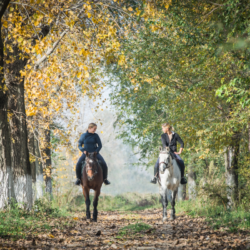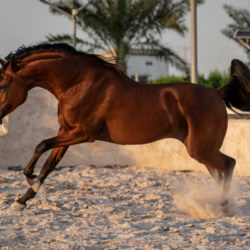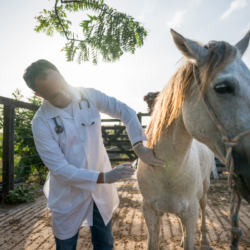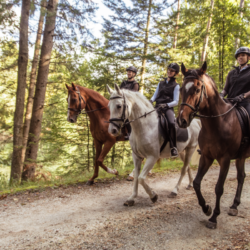Equine rhinopneumonitis is a highly contagious viral disease that affects around 65% of horses in France. Caused by two types of herpes virus (HVE-1 and HVE-4), this infection can lead to respiratory and nervous problems, as well as abortions.
What causes this disease?
Equine rhinopneumonitis is caused by two equine-specific herpes viruses: equine herpesvirus type 1 (HVE-1 ) and equine herpesvirus type 4 (HVE-4). These viruses manifest themselves in three clinical forms: respiratory, nervous and abortive. Herpes viruses persist in the horse’s body in latent form, reactivating in the event of stress or a drop in immunity, leading to a new infection. Contagion occurs mainly through inhalation of viral aerosols and contact with respiratory secretions, contaminated tissues or uterine secretions from an aborted mare.
Herpes viruses can survive for several days in the environment, but are sensitive to the usual virucidal disinfectants. In France, rhinopneumonia is monitored by RESPE through the “Abortion”, “Respiratory Syndrome” and “Nervous Syndrome” sub-networks. Vaccination is compulsory for certain breeding stock, racehorses in training and sport horses taking part in FFE “Pro” or SHF competitions.
These viruses, while highly contagious, are not transmitted to humans. However, other herpes viruses can cause illness in horses and donkeys, similar to chickenpox, shingles or cold sores in humans. A horse carrying the virus will remain infected for life, being able to excrete the virus and contaminate other horses when it reactivates. Healthy carrier horses do not show any clinical signs, but can be a source of contamination.
What are the symptoms of rhinopneumonitis?
Symptoms of rhinopneumonitis can vary considerably between individuals, with infections sometimes asymptomatic in adult horses but more serious in young horses. Fever is an important warning sign, with temperatures reaching up to 41°C. Type 1 and 4 herpes viruses can take three clinical forms: respiratory, abortive and nervous.
Respiratory form
Rhinopneumonia manifests itself mainly in the respiratory form, due essentially to HVE-4, but also to HVE-1. It resembles influenza, but the symptoms are often more moderate. General signs include hyperthermia (rectal temperature > 38.5°C), listlessness and loss of appetite. Respiratory signs include a dry cough and a serous nasal discharge, which may become mucopurulent in the event of bacterial superinfection. Signs appear 2 to 10 days after infection and the clinical phase generally lasts 1 to 2 weeks. Horses are contagious during this phase and for up to 21 days afterwards. Adult, vaccinated horses show attenuated signs, while young, unvaccinated horses may show more severe signs.
The abortive form
The abortive form is essentially due to HVE-1. It is the leading cause of infectious abortion in equidae. Abortion occurs without any premonitory signs, generally at the end of gestation (9-11 months), but can occur as early as 4 months. The foetus and placenta are expelled without difficulty, without affecting the mare. Sometimes, the foal is born at full term but has breathing difficulties, often dying within 3 days. Abortion may occur between 9 days and 4 months after infection. In a non-vaccinated population, up to 80-90% of abortions can be observed.
The nervous form
The nervous form, which is rarer, is caused by HVE-1. It causes inflammation of the brain and spinal cord, known as myeloencephalitis. Symptoms include hyperthermia, locomotor disorders, ataxia, paresis or even paralysis of the limbs, and urinary incontinence. Nervous signs may appear suddenly, often two weeks after infection. The horse’s recovery varies: some make a full recovery, while others suffer after-effects. Severe forms sometimes require euthanasia.
How is the disease diagnosed?
Diagnosis of equine rhinopneumonitis is based on PCR (Polymerase Chain Reaction) analyses, which identify the virus genome by gene amplification. These tests can be carried out on nasopharyngeal swabs for the respiratory and nervous forms, on cerebrospinal fluid for the nervous form, and on tissues (liver, abortive lung or placenta) for the abortive form.
These tests should be interpreted with caution, as some horses excrete small quantities of virus, particularly those showing nervous signs or at the beginning or end of the disease, and vaccinated horses, which sometimes give false-negative results. Early detection is crucial to effective diagnosis. In the event of clinical suspicion, it is advisable to test all horses in contact with the sick animal.
The vet may take a blood sample or nasal swab to confirm the diagnosis. In the case of an abortion, the vet will use the foetus, placenta or a vaginal swab from the mare as samples. It is also advisable to regularly monitor the body temperature of horses at risk. Fever is often the first sign to be observed.
What treatments are available?
There is currently no specific treatment for equine herpes viruses, but research is ongoing. Treatments are mainly symptomatic, to alleviate the clinical signs, in particular by combating hyperthermia.
Horses suffering from the respiratory form must be rested for at least three weeks after the clinical signs have disappeared, to allow the respiratory system to heal. Non-steroidal anti-inflammatory drugs are often used to reduce fever.
For the nervous form, additional supportive treatments may be required depending on the clinical signs observed. Placing the horse in a harness can help prevent falls and facilitate movement.
In the abortive form, abortion is generally not followed by any complications or sequelae, so no specific treatment is required. There is no preventive treatment to avoid abortion after a mare has been infected.
Studies have demonstrated the efficacy of valganciclovir, an antiviral, against HVE-1. Its combination with decitabine could also be promising, showing a synergistic effect in vitro. However, these treatments are not yet available for routine use.
What are the natural alternatives?
Natural treatments can complement conventional care for horses suffering from rhinopneumonitis.
- Eucalyptus is antiseptic, expectorant, decongestant and cough suppressant. It thins and eliminates bronchial secretions, making breathing easier.
- Thyme has antibacterial, tonic, respiratory and cough-relieving properties. It soothes bronchial muscle spasms, improving respiratory comfort.
- Pine bud is expectorant and decongestant. It increases the respiratory capacity of horses.
- Marshmallow soothes irritation of the bronchial mucous membranes, reducing their hyper-secretion and improving breathing.
- Hyssop is a bronchial secretion fluidifier, expectorant and cough suppressant, helping to eliminate obstructive secretions.
- Rosehip, rich in vitamin C, is an antioxidant that reinforces the protective mucus of the lung membranes.
- Burdock helps to eliminate toxins and metabolic waste products, supporting the horse’s overall health.
- Echinacea stimulates the immune system by increasing the production of white blood cells and the synthesis of interferon, a substance essential to immunity.
- Acerola, which is very rich in vitamin C, is recommended as a preventive measure, particularly in cases of fatigue or at the onset of winter, to support the immune system and prevent the development of latent diseases such as rhinopneumonia.
What are the means of prevention?
Vaccination is a central pillar of prevention against herpes viruses. Although it does not prevent nerve infections, it reduces the severity and duration of clinical signs, as well as viral excretion, thereby limiting contagiousness.
It is advisable to start vaccination at six months of age with a primary inoculation of two injections one month apart, followed by a booster at six months, then annual or six-monthly boosters. In pregnant mares, a booster in the four to six weeks before foaling is recommended.
Batch management of equidae, quarantine of new arrivals, close monitoring with daily temperature readings, and the establishment of a care circuit (from healthy equidae to sick ones) are essential. The use of specific equipment for each batch of horses and regular disinfection of facilities and equipment are crucial.
In the event of an outbreak, it is essential to isolate sick and suspect horses, stop all movement of horses, monitor the temperature of healthy horses for a week, and disinfect equipment and facilities. Disposable gloves should be used when handling runts, and it is important to prevent any contact with other animals.
Vaccination combined with rigorous stable management can minimise the risk of epidemic outbreaks. Regular vaccination and compliance with sanitary measures are essential to maintain the health of horses and prevent the spread of rhinopneumonitis.





